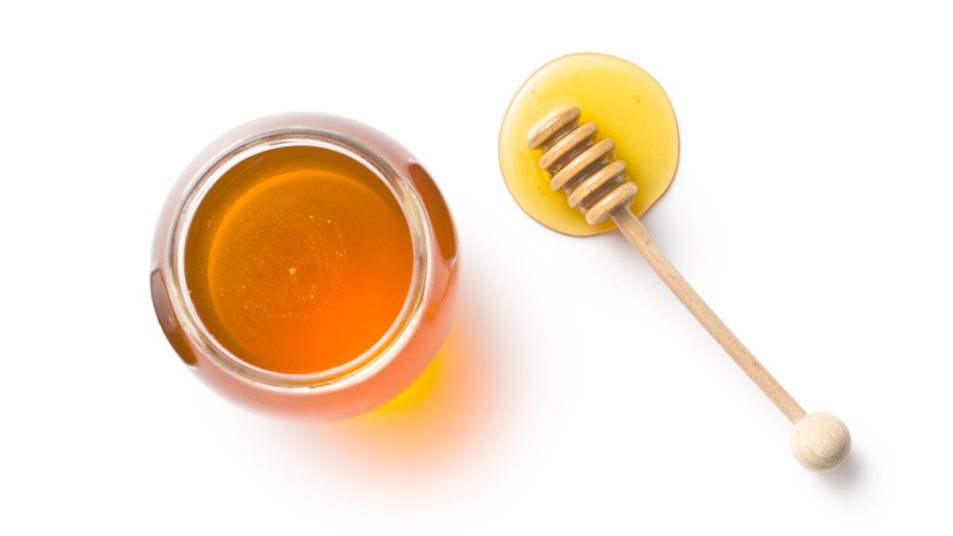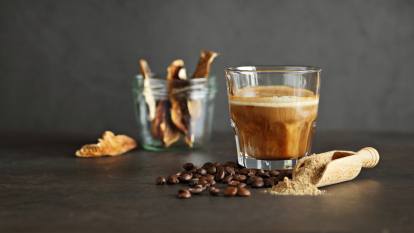9 Smart Uses for Honey That Prove You Always Need It In Your Cabinet
It's mother nature's gold.

What is it about honey that makes it a pantry staple? It goes well with everything — toast and butter, fresh cornbread, teriyaki chicken (mix it with soy sauce to make a quick dip), and so much more. But it’s not just for making delicious food. Honey can help freshen breath, relieve itchy bug bites, get rid of ants, soothe a pup’s upset stomach, and even keep your hair lush and shiny. Find out all the ways you can use nature’s treat below.
1: Freshen breath in a pinch.
Argh! You’re in the middle of your morning routine and discover that you’re out of mouthwash. The quick save: Mix 1 tablespoon of honey with 1 cup of warm water, then gargle for 30 seconds. Spit and rinse your mouth with water. Antiseptic agents in the honey help nix plaque-causing bacteria that can lead to less-than-fresh breath. Aah…that’s better!
2: Take the itch out of bug bites.
Your afternoon of hiking was revitalizing — if only you didn’t walk away from the experience covered in itchy bug bites. For quick relief, rub a small amount of honey onto each bite. The anti-inflammatory will soothe irritated skin, reducing the urge to scratch.
3: Eliminate an ant problem.
The warmer weather almost always ensures an army of ants makes its way into your home. To banish them, mix 1 tablespoon of honey and 2 teaspoons of borax; place onto small cardboard pieces and set in areas where you’ve seen the bugs. (Note: Keep away from children and pets.) Ants love honey, so they’ll carry it — along with the borax, which is toxic to them — back to their nests.
4: Treat a dog’s tummy troubles.
Sneaky Rover got into a bag of treats and is now acting rather sluggish — a sure sign he ate way too much. To ease his stomach woes, reach for some honey. Just grab a small spoonful of the honey and allow him to lick it all off. The sweet staple contains enzymes that work to aid digestion, so he’ll be feeling better and acting like himself again in no time! (Note: Just a little is all you need. The American Kennel Club notes that honey is safe in small quantities, and should not be given to dogs with compromised immune systems.)
5: Tame an overly spicy salsa.
If the salsa you whipped up for your neighborhood potluck is much hotter than expected, try this: Stir a spoonful of honey and a squeeze of lime juice into the salsa. Together, the honey’s sugar and the lime’s citric acid cut down on the heat from the peppers, ensuring a delicious and mild salsa.
6: Boost hair’s natural shine.
Summer sun leave your hair looking dry and straw-like? Mix 2 tablespoons each of honey and olive oil, warm in the microwave and apply all over hair. Wrap your head with a towel and let it sit for 30 minutes; rinse. Conditioning agents in honey and oil rehydrate hair for a more lustrous appearance.
7: Heal a scrape naturally.
Ouch! You tripped outside and scraped your knee, but can’t find your go-to antibiotic ointment. Enlist the help of honey. The liquid gold has antibacterial properties, helping it kill germs that could contribute to an infection. Plus, the honey will retain water molecules to keep skin moist and prevent any scarring. Simply wash and dry the area, apply a thin coat of honey, and cover with a bandage.
8: Fall asleep with ease.
When you need to catch up on your Zzzs but are struggling to drift off, grab a jar of honey! Simply eat a spoonful of the kitchen staple before heading to bed. The sweet liquid contains sleep-inducing tryptophan, which means you’ll fall asleep quickly and enjoy a restful night.
9: Ensure fresh-cut flowers last.
The pretty bouquet you created from blooms in your garden really brightens up your house. The secret to helping the display last for days: Add 1 tablespoon each of honey and vinegar to the vase every time you change the water. Sugar in the honey provides nourishment, while acid in the vinegar destroys wilt-causing bacteria. You’ll get to enjoy your flowers even longer!
A version of this article originally appeared in our print magazine, First for Women.













